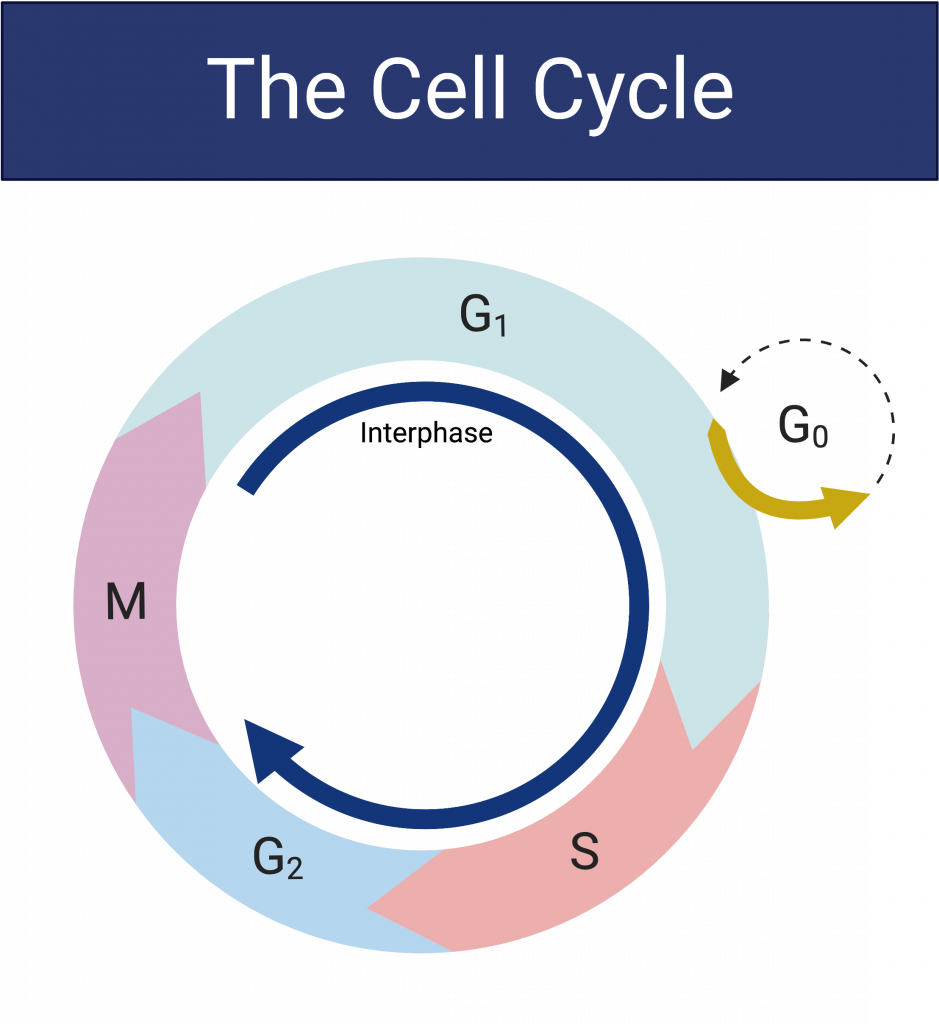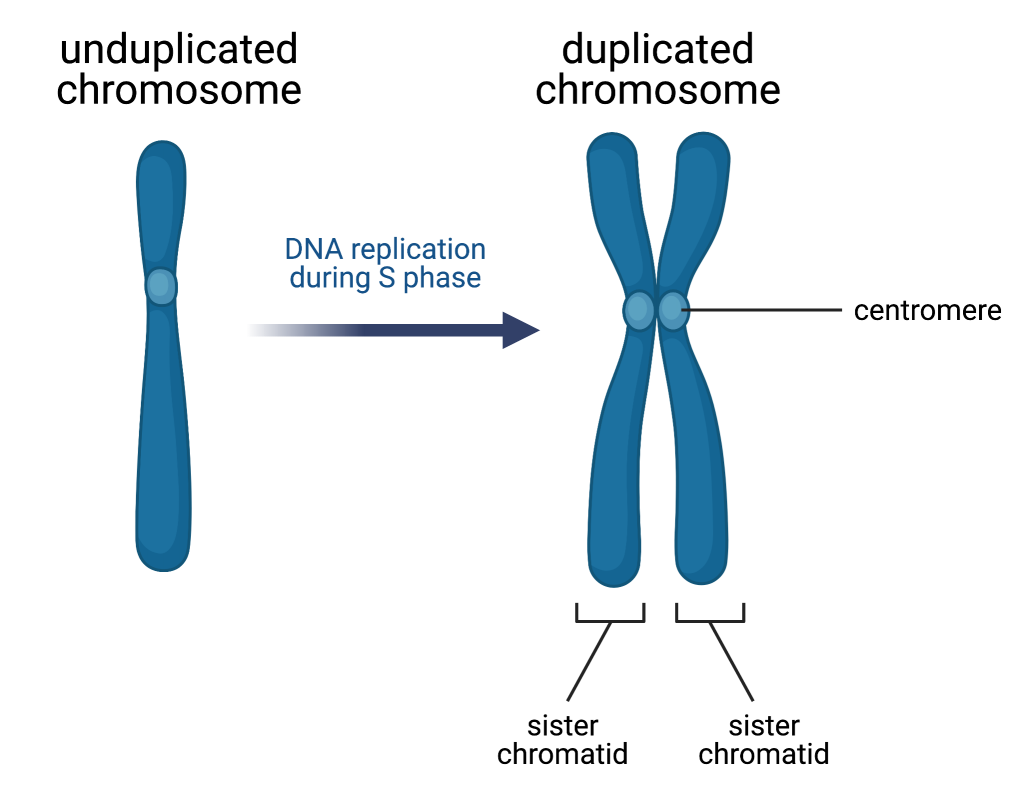16.2 The Cell Cycle
The Cell Cycle
The cell cycle is an ordered series of events involving cell growth and cell division that produces two new daughter cells. Cells on the path to cell division proceed through a series of precisely timed and carefully regulated stages of growth, DNA replication, and nuclear and cytoplasmic division that ultimately produces two identical (clone) cells. The cell cycle has two major phases: interphase and the mitotic phase. During interphase, the cell grows and DNA is replicated. During the mitotic phase, the replicated DNA and cytoplasmic contents are separated. Cytokinesis is the term used to refer to the partitioning of cytoplasmic contents into two daughter cells.

Interphase
During interphase, the cell undergoes normal growth processes while also preparing for cell division. In order for a cell to move from interphase into the mitotic phase, many internal and external conditions must be met. The three stages of interphase are called G1, S, and G2.
G1 Phase (First Gap)
The first stage of interphase is called the G1 phase (first gap) because, from a microscopic point of view, little change is visible. However, during the G1 stage, the cell is quite active at the biochemical level. The cell is accumulating the building blocks of chromosomal DNA and the associated proteins as well as accumulating sufficient energy reserves to complete the task of replicating each chromosome in the nucleus. The cell is also growing in size due to gene expression and the synthesis of biological molecules such as phospholipids and proteins.
S Phase (Synthesis of DNA)
Throughout interphase, nuclear DNA remains in a semi-condensed chromatin configuration. In the S phase, DNA replication can proceed through the mechanisms that result in the formation of identical pairs of DNA molecules—sister chromatids—that are attached to one another at the centromere.

The centrosome is also duplicated during the S phase. The two centrosomes of homologous chromosomes will give rise to the mitotic spindle, the apparatus that orchestrates the movement of chromosomes during mitosis. In animal cells, the centrosomes are located near the nucleus and each is associated with a pair of rod-like objects, the centrioles, which are positioned at right angles to each other. Centrioles help organize cell division. We should note, however, that centrioles are not present in the centrosomes of other eukaryotic organisms, such as plants and most fungi.
G2 Phase (Second Gap)
In the G2 phase, the cell replenishes its energy stores and synthesizes proteins necessary for chromosome manipulation and movement. Some cell organelles are duplicated, and the cytoskeleton is dismantled to provide resources for the mitotic phase. There may be additional cell growth during G2. The final preparations for the mitotic phase must be completed before the cell is able to enter the first stage of mitosis.
G0 Phase
Not all cells adhere to the classic cell-cycle pattern in which a newly formed daughter cell immediately enters the preparatory phases of interphase, closely followed by the mitotic phase, and cytokinesis. Cells in G0 phase are not actively preparing to divide. The cell is in a quiescent (inactive) stage that occurs when cells exit the cell cycle. Some cells enter G0 temporarily due to adverse environmental conditions such as scarcity of nutrients, or stimulation by growth factors. The cell will remain in this phase until conditions improve or until an external signal triggers the onset of G1. Other cells that never or rarely divide, such as mature cardiac muscle and nerve cells, remain in G0 permanently.
The Mitotic Phase
The mitotic phase is a multistep process during which the duplicated chromosomes are aligned, separated, and are moved into two identical daughter cells. The first portion of the mitotic phase is called karyokinesis, or nuclear division. As we have just seen, the second portion of the mitotic phase (and often viewed as a process separate from and following mitosis) is called cytokinesis—the physical separation of the cytoplasmic components into the two daughter cells.
ordered series of events involving cell growth and cell division that produces two new daughter cells
period of the cell cycle leading up to mitosis; includes G1, S, and G2 phases (the interim period between two consecutive cell divisions)
period of the cell cycle during which duplicated chromosomes are distributed into two nuclei and cytoplasmic contents are divided; includes karyokinesis (mitosis) and cytokinesis
division of the cytoplasm following mitosis that forms two daughter cells
(also, first gap) first phase of interphase centered on cell growth during mitosis
second, or synthesis, stage of interphase during which DNA replication occurs
one of the two identical copies that makes up half of a duplicated chromosome
region at which sister chromatids are bound together
region in animal cells made of two centrioles that serves as an organizing center for microtubules
apparatus composed of microtubules that orchestrates the movement of chromosomes during mitosis
rod-like structure constructed of microtubules at the center of each animal cell centrosome
(also, second gap) third phase of interphase during which the cell undergoes final preparations for mitosis
a quiescent phase outside of the cell cycle; a cell in G0 is not preparing to divide
division of the nucleus into two daughter nuclei

